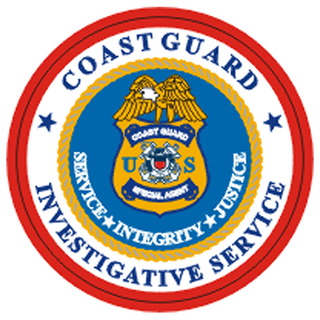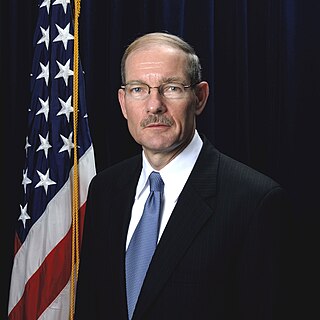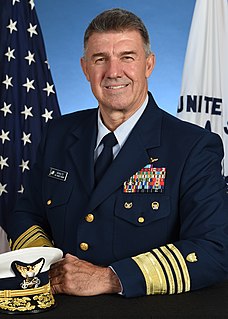
The United States Coast Guard (USCG) is the maritime security, search and rescue, and law enforcement service branch of the United States Armed Forces and one of the country's eight uniformed services. The Coast Guard is a maritime, military, multi-mission service unique among the U.S. military branches for having a maritime law enforcement mission with jurisdiction in both domestic and international waters and a federal regulatory agency mission as part of its duties. It operates under the U.S. Department of Homeland Security during peacetime, and can be transferred to the U.S. Department of the Navy under the Department of Defense by the U.S. President at any time, or by the U.S. Congress during times of war. Prior to its transfer to Homeland Security, it operated under the Department of Transportation from 1967 to 2003 and the Department of the Treasury from its inception until 1967. A congressional authority transfer has only happened once: in 1917, during World War I. When the U.S. entered World War II in December 1941, the Coast Guard had already been transferred by Franklin Roosevelt in November.

USCGC Healy (WAGB-20) is the United States' largest and most technologically advanced icebreaker as well as the US Coast Guard's largest vessel. She is classified as a medium icebreaker by the U.S. Coast Guard. She is homeported in Seattle, Washington, and was commissioned in 1999. On 5 September 2015, Healy became the first unaccompanied United States surface vessel to reach the North Pole.

The United States Coast Guard Auxiliary is the uniformed volunteer component of the United States Coast Guard. Congress established the unit on June 23, 1939, as the United States Coast Guard Reserve. On February 19, 1941, the organization was re-designated as the United States Coast Guard Auxiliary. The Auxiliary exists to support all USCG missions on the water or in the air, except for roles that require "direct" law enforcement or military engagement. As of 2018, there were approximately 24,000 members of the U.S. Coast Guard Auxiliary.

John William Kime was a United States Coast Guard admiral who served as the 19th Commandant of the Coast Guard from 31 May 1990 to 1 June 1994.
Awards and decorations of the United States government are civilian awards of the U.S. federal government which are typically issued for sustained meritorious service, in a civilian capacity, while serving in the U.S. federal government. Certain U.S. government awards may also be issued to military personnel of the United States Armed Forces and be worn in conjunction with awards and decorations of the United States military. In order of precedence, those U.S. non-military awards and decorations authorized for wear are worn after U.S. military personal decorations and unit awards and before U.S. military campaign and service awards.

The Coast Guard Investigative Service (CGIS) is a division of the United States Coast Guard that investigates crimes where the U.S. Coast Guard has an interest. It is composed of civilian (GS-1811), active duty, reserve enlisted, and warrant officer special agents.

Franklin A. Welch was the ninth Master Chief Petty Officer of the United States Coast Guard. Welch entered the Coast Guard in 1980 after graduating from Shades Valley High School Class of 1978, in Birmingham, Alabama. A former Master Chief Quartermaster, he served in office from October 10, 2002 to June 14, 2006, and served in the Coast Guard for over 26 years.

Harvey Elwood Johnson Jr., retired Vice Admiral, United States Coast Guard, is the President of Humanitarian Services for the American Red Cross. Previously, Johnson was the former Vice President for National Preparedness and Response Solutions at BAE Systems and Deputy Administrator and Chief Operating Officer of the Federal Emergency Management Agency (FEMA).
Awards and decorations of the state defense forces are presented to members of the state defense forces in addition to regular United States military decorations and state National Guard military decorations. Each of the state governments of the United States maintains a series of decorations for issuance to members of the state defense forces, with such awards presented under the authority of the various state adjutants general and/or respective state defense force commanders.
The history of the United States Coast Guard goes back to the United States Revenue Cutter Service, which was founded on 4 August 1790 as part of the Department of the Treasury. The Revenue Cutter Service and the United States Life-Saving Service were merged to become the Coast Guard per 14 U.S.C. § 1 which states: "The Coast Guard as established January 28, 1915, shall be a military service and a branch of the armed forces of the United States at all times." In 1939, the United States Lighthouse Service was merged into the Coast Guard. The Coast Guard itself was moved to the Department of Transportation in 1967, and on 25 February 2003 it became part of the Department of Homeland Security. However, under 14 U.S.C. § 3 as amended by section 211 of the Coast Guard and Maritime Transportation Act of 2006, upon the declaration of war and when Congress so directs in the declaration, or when the President directs, the Coast Guard operates as a service in the Department of the Navy.

Ronald James Rábago is a retired United States Coast Guard rear admiral who in 2006 became the first person of Hispanic American descent to be promoted to flag rank in the United States Coast Guard. He retired as the assistant commandant for engineering and logistics and the United States Coast Guard's chief engineer in 2014.

Steven E. Day is a United States Coast Guard rear admiral who currently serves as the director of Reserve and leadership, (CG-13). In this role he also commands the United States Coast Guard Reserve. He previously served as the US deputy commander for mobilization and reserve affairs, Atlantic Area, US Coast Guard.
Daniel S. Mastagni is a retired Rear Admiral of the United States Navy Reserve who, from July to September 2003 served as Commander Naval Forces Korea.

Cari Batson Thomas is a retired rear admiral in the United States Coast Guard and a 1984 graduate of the U. S. Coast Guard Academy. On January 22, 2010, Thomas was ceremoniously advanced to rear admiral and became the third recent female commander of the training center to be advanced to a flag officer. Her final assignment was Assistant Commandant for Human Resources at the Coast Guard Academy.

David Peter Pekoske is an American government official and retired U.S. Coast Guard vice admiral who currently serves as the seventh administrator of the Transportation Security Administration in the United States Department of Homeland Security (DHS). On January 20, 2021, at the request of President Joe Biden, he became the senior official performing the duties of the deputy secretary of Homeland Security. From January 20, 2021 to February 2, 2021 he served as acting secretary of homeland security, during the Senate confirmation of Alejandro Mayorkas. He also served as acting deputy secretary from April to November 2019. Pekoske retired with 33 years of active military service in 2010 as the 26th vice commandant of the Coast Guard.
Captain Charley L. Diaz is a 30-year United States Coast Guard veteran who served on Active Duty from 1982 to 2012. Diaz is best known for leading the crew of the USCGC Sherman (WHEC-720) in the seizure of the Panamanian freighter GATUN off the coast of Panama in March 2007, which netted nearly 20 tons of cocaine worth an estimated $600 million. It was the largest maritime drug bust in US history.
Robert S. Lucas is a former rear admiral in the United States Coast Guard.

Karl Leo Schultz is an American United States Coast Guard admiral serving as the 26th Commandant of the Coast Guard.












